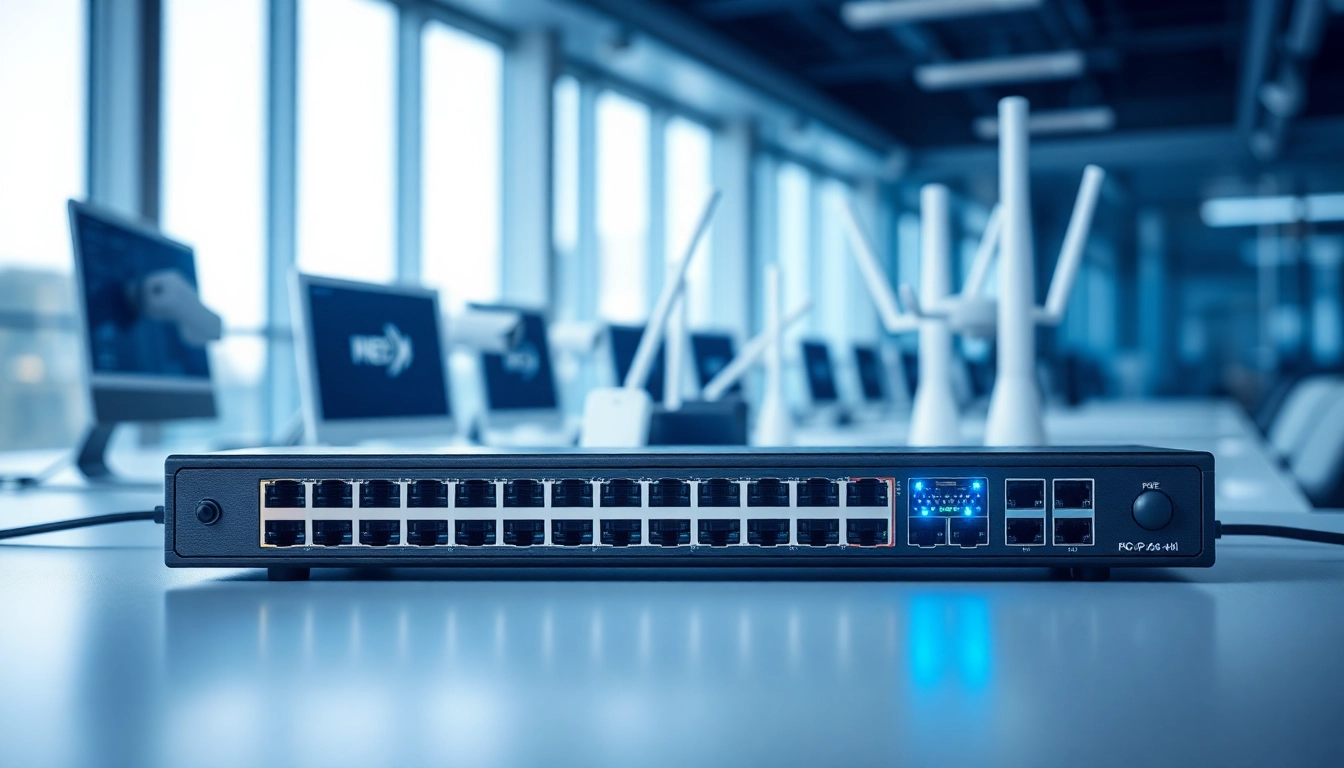What is a POE Switch?
Power over Ethernet (PoE) technology has revolutionized how we set up and manage networking infrastructure. A POE Switch is a central component that allows the transmission of both power and data through a single Ethernet cable. This not only simplifies installations but also minimizes the complexity related to electrical wiring, thereby offering a streamlined solution for powering network devices.
Understanding Power Over Ethernet Technology
PoE technology enables the delivery of electrical power via Ethernet cables alongside data, ideally catering to devices such as IP cameras, VoIP phones, wireless access points, and various IoT devices. This is achieved through standards defined by the Institute of Electrical and Electronics Engineers (IEEE), particularly the 802.3af and 802.3at standards, which govern how power is safely transmitted over the existing network cabling.
How POE Switches Work: Key Features
A POE Switch acts as the power source for connected devices. It incorporates a Power Sourcing Equipment (PSE) feature that delivers power through the Ethernet cables to powered devices (PDs). Some critical features include:
- Automatic Detection: POE switches can automatically detect if a connected device is PoE-compatible and supply the necessary power without manual configuration.
- Port Configuration: Various models offer different port configurations, with options for standard PoE and advanced PoE+ capabilities to support higher power devices.
- Management Features: Managed POE switches offer extensive monitoring, management, and optimization options, enabling better control over power allocation and network performance.
Types of POE Switches Available
POE switches come in various configurations and capabilities to suit diverse applications. The common types include:
- Unmanaged POE Switches: Simple plug-and-play devices with no configuration required, perfect for small networks.
- Managed POE Switches: Provide comprehensive network management features, allowing for monitoring, configuration, and optimization.
- Smart POE Switches: A hybrid between unmanaged and managed switches, offering some level of configuration and monitoring without the full feature set of managed switches.
Benefits of Using a POE Switch
Opting for a POE Switch comes with several significant advantages that enhance both efficiency and reliability within a network. Here are some notable benefits:
Cost-Efficiency and Simplified Installation
Simplified cabling is one of the most significant cost-saving features of POE technology. By transmitting power and data over a single Ethernet cable, organizations can reduce costs associated with multiple cables and the labor required for installation. This streamlined installation process also leads to quicker deployment times, making it an attractive option for both small and large networks.
Enhanced Network Management and Scalability
Modern POE switches, particularly managed ones, offer sophisticated network management features. Network administrators can monitor device status, power performance, and overall network health from a centralized interface. This not only allows for quick adjustments and troubleshooting but also supports scalability, as new devices can easily be integrated without the need for additional electrical outlets or structures.
Improved Safety and Reliability
POE technology is inherently designed with safety in mind. It incorporates mechanisms such as auto-discovery, which prevents overload by ensuring only compatible devices receive power. Furthermore, using a centralized power source minimizes the risk of electrical hazards associated with multiple power adapters, enhancing overall reliability.
Choosing the Right POE Switch for Your Needs
When it comes to selecting a POE Switch, understanding your specific requirements is crucial. Below are some factors to consider during your selection process.
Assessing Your Power Requirements
Different devices require varying power levels. Therefore, it’s essential to assess the total power budget for all connected devices. For example, standard PoE supplies up to 15.4 watts per port, while PoE+ can deliver up to 30 watts. If your network includes devices like PTZ cameras or high-powered wireless access points, a PoE+ switch may be necessary.
Port Configuration: What to Consider
The number of ports on a POE Switch can vary widely—common configurations include 4, 8, 16, and 24 ports. Consider not only your current device count but also future needs. Opt for a switch that provides room for growth to avoid having to replace equipment soon after installation.
How to Compare Different POE Switch Models
Evaluating POE switches involves comparing several criteria including:
- Power budget per port: Ensure that the switch meets the power needs of all connected devices.
- Data transfer rates: Look for switches that support Gigabit Ethernet if high-speed data transfer is a requirement.
- Managed vs. unmanaged: Decide whether you need advanced management features based on the complexity and size of your network.
Installation and Setup of a POE Switch
Installing a POE Switch requires careful planning and execution to ensure a seamless integration into your existing network infrastructure. Here’s a comprehensive guide on how to effectively set it up.
Essential Tools and Materials Needed
Before initiating the installation process, gather the following essential tools and materials:
- Punchdown tool
- Ethernet cables (Cat5e, Cat6, or Cat6a)
- POE Switch
- Network devices to be powered (e.g., IP cameras, access points)
- Proper mounting hardware (if applicable)
Step-by-Step Installation Guide
Follow these steps for the installation of a POE Switch:
- Plan your network layout: Identify where the POE Switch will be installed, and ensure it’s close to existing network wiring to minimize cable lengths.
- Connect the switch to a power source: Ensure that the switch is connected to a reliable power source to avoid interruptions.
- Connect network devices: Using Ethernet cables, connect each power-enabled device to the switch. Ensure that each cable is securely plugged into the corresponding port.
- Test the connection: Confirm that all devices successfully receive power and data from the POE Switch. This can usually be done using the LED indicators present on the switch.
- Document the setup: Taking notes on device locations and configurations can help in troubleshooting and future modifications.
Troubleshooting Common Installation Issues
During installation, several issues may arise. Here are common challenges and how to troubleshoot them:
- Device not receiving power: Verify cable connections, check for the compatibility of devices, and ensure they are within the power budget.
- Network slowdowns: Confirm that the switch can handle the total bandwidth required by connected devices and consider upgrading if necessary.
- Intermittent connectivity: Test cables for damage, ensure connectors are clean and undamaged, and verify that devices are functioning correctly.
Maintaining Your POE Switch
Regular maintenance of your POE Switch is crucial to ensure optimal performance and longevity of your network infrastructure. Here are best practices for upkeep.
Best Practices for Regular Maintenance
Maintaining your POE Switch involves routine checks and updates. Regularly inspect the physical condition of the switch, ensure unobstructed airflow to prevent overheating, and keep the firmware updated to patch security vulnerabilities or improve functionality.
Identifying and Resolving Performance Issues
Stay attuned to network performance and look for signs of potential issues, such as latency or dropped connections. Utilizing the management interface of a managed POE Switch can provide valuable data on traffic patterns, helping you identify the source of problems quickly.
Upgrading Your POE Switch: When and How
Knowing when to upgrade is vital for optimal performance. You may need to consider upgrading if:
- You’re experiencing frequent connectivity issues or performance bottlenecks.
- Your network has expanded beyond the current switch’s capacity.
- New devices requiring more advanced features become necessary for your operations.
To upgrade, evaluate the current and future network requirements, choose a suitable POE Switch model that addresses gaps, and follow the installation guide provided in this article for a seamless transition.



